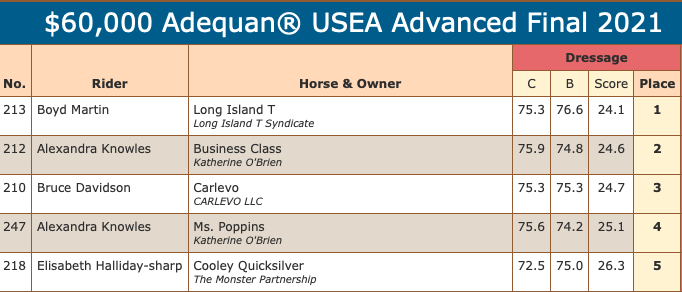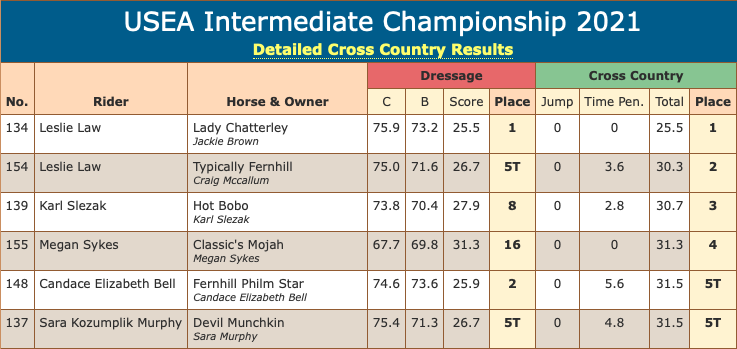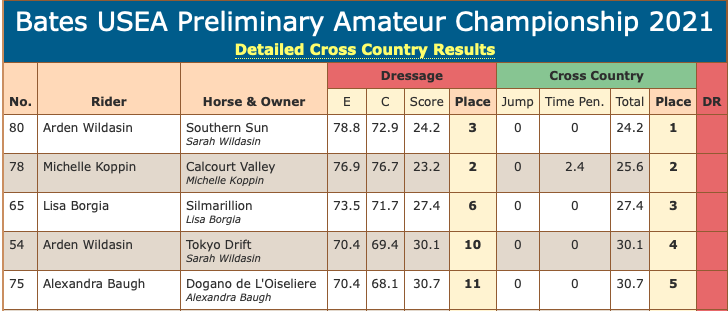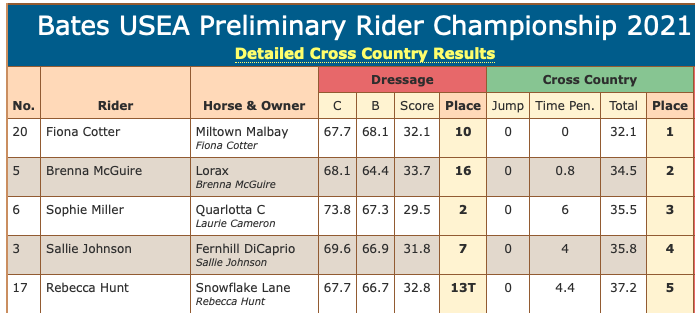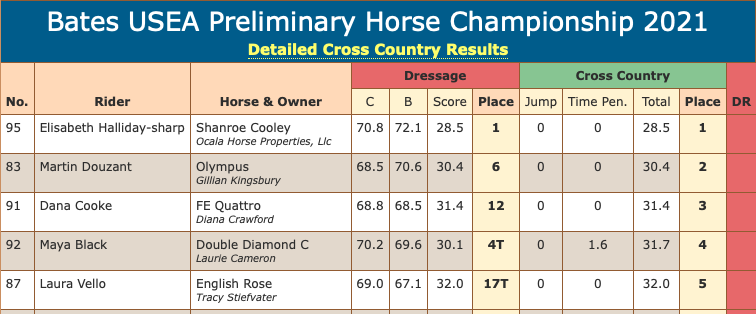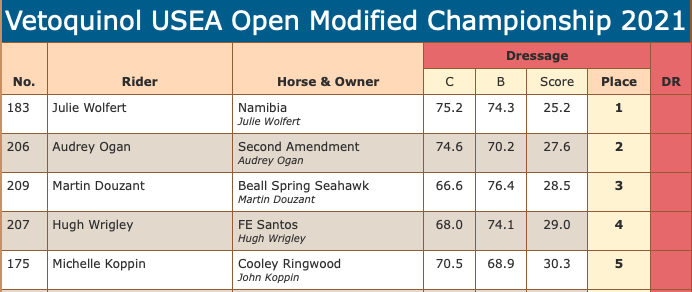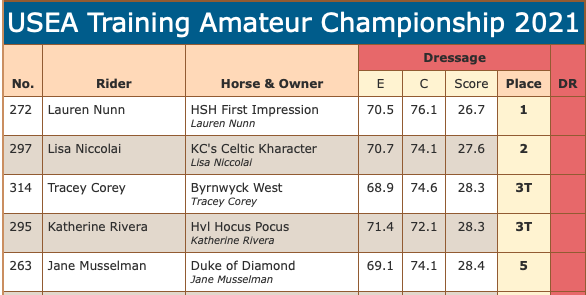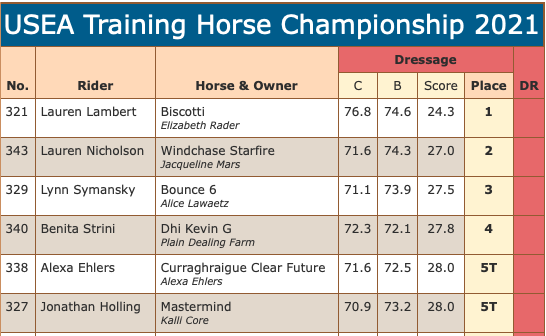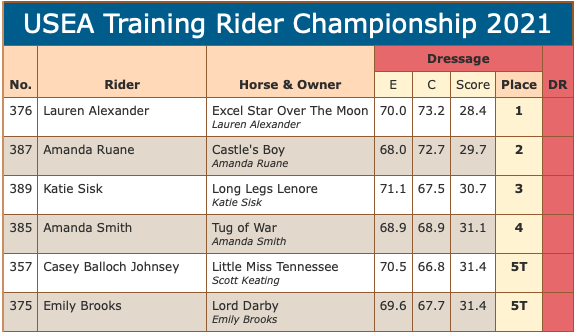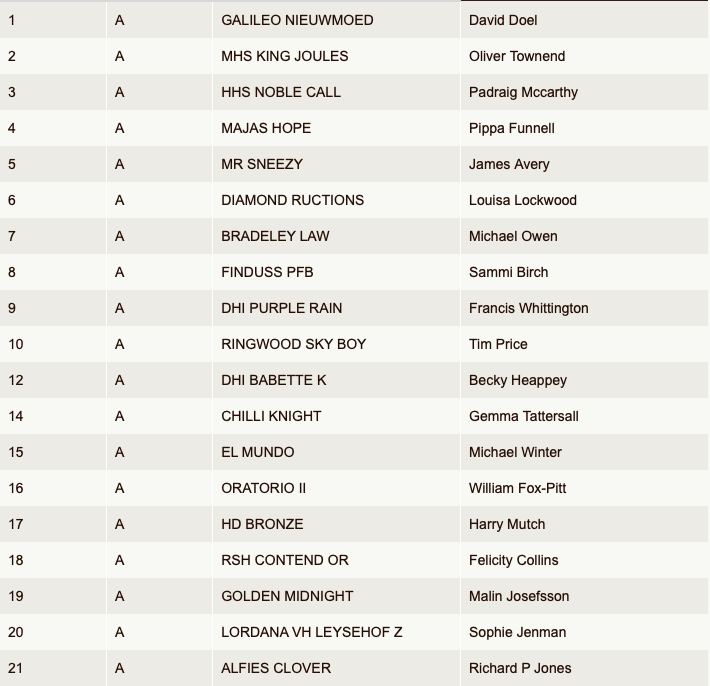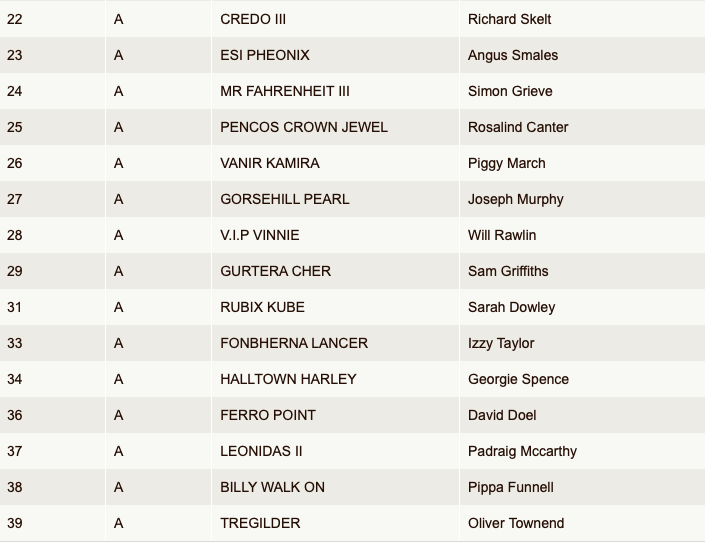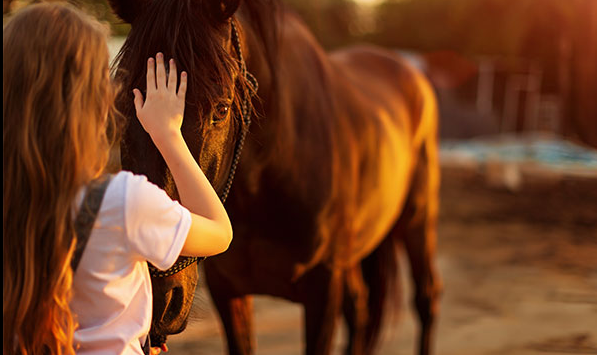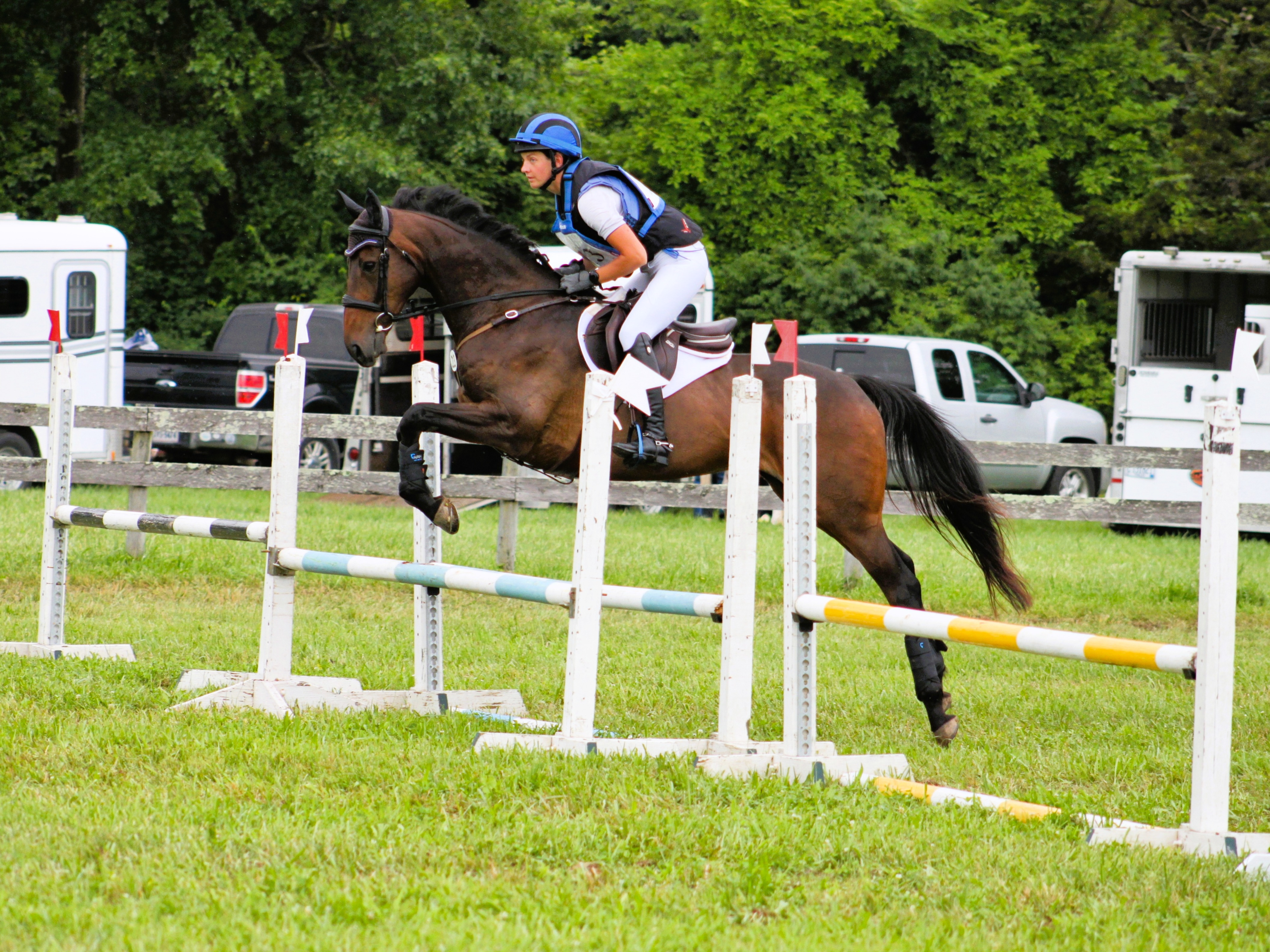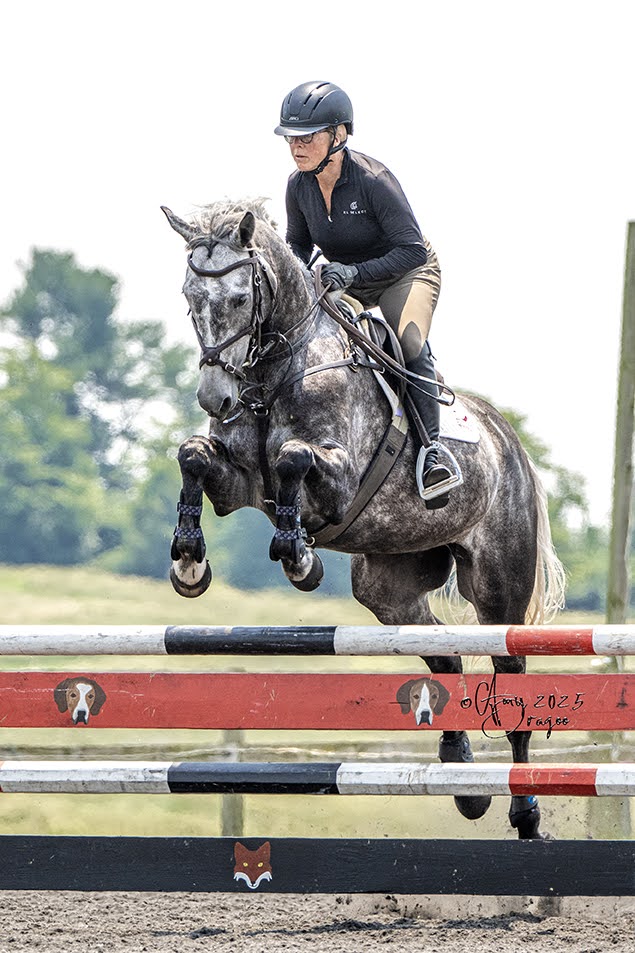
Piggy March and Vanir Kamira. Photo by Hannah Cole Photography.
Started from the bottom (a calendar cleared out by the coronavirus and sad texts to our farriers saying “no stud holes this time, thanks”), now we here (a history-making first-ever ‘pop-up’ CCI5* to make up for the two-year loss of Badminton and Burghley). It’s hard to know quite what to expect as we head into the wild, wild West Country, but there’s an unmistakeable buzz in the air as we venture forth into Britain’s first five-star since 2019.
And what a cool line-up of horses and riders we’ve got! Interspersed with five-star winners and superstars of the sport are some very exciting young horses and some riders making their debut, too. From breast cancer survivors to full-time healthcare workers, anti-racism allies to potential Love Island cast members, there’s an eclectic and vibrant mix of competitors for you to cheer on through the course of the week. As we prepare for this afternoon’s first horse inspection, let’s meet the horses and riders who’ll be battling for victory at Bicton…
Chedington Bicton CCI5*: [Website] [Box Office] [Entries] [Course Preview] [Live Stream] [EN’s Coverage] [EN’s Instagram] [EN’s Twitter]
AUSTRALIA

Sammi Birch and Finduss PFB. Photo by Tilly Berendt.
Sammi Birch and Finduss PFB
DEBUTANT HORSE
Eleven-year-old Dutch Warmblood gelding (Saffier x Belle Miranda, by Sarantos). Owned by Parkfield Breeding and the rider.
Talented Finduss PFB has been produced by a few leading ladies of the sport — first Holly Woodhead, who used to be Parkfield Breeding’s rider in residence and took him to the Seven Year Old World Championships and his first forays at four-star, and then, very briefly, by Laura Collett. He moved to British-based Australian Sammi’s string in early 2019 and has gone from strength to strength since, with classy clears and top ten finishes in four-star classes at Barroca d’Alva, as well as clear rounds at Burgham CCI4*-S and Bicton’s CCI4*-L earlier this summer, where he finished twentieth.
Sammi, who beginner career riding ex-racehorses and relocated to England back in 2005, is one of Australia’s biggest star, and perhaps best known in conjunction with her top horse Hunter Valley II, with whom she was fourth at Pau in 2017. She’s also tough as nails, though it’s rare to see her without a warm smile on her face: in 2018, she was diagnosed with breast cancer, and went through chemotherapy and a major surgery to remove the cancerous cells while still riding and competing at the top level. She balanced that with raising her young son and dealing with the heartbreak of missing the WEG that year due to a horse injury.
This will be her first five-star since that super result at Pau in 2017, and although it’s a step up for the young horse, it’ll be an exciting week for Sammi, the gelding’s connections, and all of us as spectators to see what he’s made of. His dressage is still a work in progress and can fluctuate between the low-30s and low-40s, and in Bicton’s atmospheric main arena, it’s to be expected that he might err towards the latter. But since Boekelo at the end of 2019, where they picked up a 20 in the early stages of their partnership, this pair have been on great form and should make an impressive debut over Captain Mark Phillips’s tough track. They won’t be among the fastest in the field, but a moderate clear will see them climb — and then on Sunday they’ll have a job on their hands to try to avoid their customary one rail, which has sometimes escalated to two or three in the past.

Sam Griffiths and Gurtera Cher. Photo by Tilly Berendt.
Sam Griffiths and Gurtera Cher
DEBUTANT HORSE
Sixteen-year-old Irish Sport Horse mare (Touchdown x Princess H of T, breeding unknown). Owned by the Kim and Imogen Syndicate and Rod and Sue Bennett.
Badminton winner Sam brings forward a first-timer — and one of just seven mares in this field — in the Irish-bred Gurtera Cher, who is deceptively low-mileage for her age. This will be just her 15th FEI run in a career that began back in 2012 but saw her sidelined until 2016 after her CCI2*-S debut. She was lightly campaigned in 2017, too, with just one FEI start under her belt that year, and, unsurprisingly, 2020 was a scant year for the mare. But she’s had some exciting moments along the way in her stop-start career, including a win in Arville’s CCI4*-S back in 2018 and victory in the CCI3*-L at hilly Blair Castle back in 2017, when Sam’s great friend Shane Rose deputised for him while he recovered from a broken neck.
After that Arville victory, her four-star record can best be described as steady and solid, rather than sparkling. She’s not generally competitive in Britain’s typically enormous four-star fields, which can number well over 100 entries and feature much of the top of the FEI World Rankings. But you do know what you’re going to get with her, and that’s a dressage around 37, a a steady clear across the country, and — her piéce de resistance — a rock-solid showjumping round that’ll almost certainly add nothing to her score. She’s not ultra-flash and super-fast, which means she’s often overlooked, but in a tough week like the one to come, her reliability will prove invaluable, and we should see her produce one of the biggest leaderboard climbs of the week.
CANADA

Mike Winter and El Mundo. Photo by Tilly Berendt.
Mike Winter and El Mundo
DEBUTANT HORSE
Twelve-year-old Dutch Warmblood gelding (Numero Uno x Calvaro’s Bria Z, by Calvaro F.C.). Owned by Jonathan Nelson, Emma Winter, and the rider.
What a joy it is to welcome Mike back to five-star for the first time in twelve years — the last time we saw him at this level was back in 2009, when he had King Pin and Wonderful Will at Kentucky. This time, he brings forward the bold, keen El Mundo, who last left the start box at Hartpury CCI4*-S, where he gleefully told his rider the whole way around that not a single one of the fences was big enough for him.
El Mundo, like Gurtera Cher, is often overlooked in overflowing CCI4*-S sections, which require a very specific type of horse for a placing — namely, one that can put a 23 dressage on the board and then nip round in no time at all. Watching El Mundo as he’s become physically stronger, though, it’s easy to see how he could come into himself when given a real stamina test, which would allow him to settle into a rhythm, stay rideable, and climb from his low-30s first-phase score. He’s relatively inexperienced, and does have a blip at CCI4*-L on his record back at Tattersalls in 2019, but this could be a real turning point for the horse.
Mike, who’s represented Canada at two Olympics, is certainly not lacking in experience, and he’s also an outspoken advocate for diversity and anti-racism in the sport. We hope to catch him on course in his Black Lives Matter stirrup irons this week, and however the event pans out for him, he’ll be a welcome reminder to spectators that the sport’s doors are open to them, no matter what.
GREAT BRITAIN

Ros Canter and Pencos Crown Jewel. Photo by Tilly Berendt.
Ros Canter and Pencos Crown Jewel
DEBUTANT HORSE
Twelve-year-old British-bred Sport Horse mare (Jumbo x Cornish Queen, by Rock King). Owned by Kate James and Annie Makin.
World Champion Ros Canter has a number of seriously nice up-and-coming horses on the go at the moment, and one of them is five-star first-timer Pencos Crown Jewel, who’s one of just a tiny handful of mares in this field. She comes back to Bicton after a successful run in that achingly tough CCI4*-L here back in June, where she finished ninth on a swift double-clear. That’s the toughest track we’ve seen her tackle in a while — prior to that, she had runs in both this spring and last autumn’s Burnham Market four-stars, which weren’t particularly tricky for the level, and at Burgham last year, where they had an unfortunate fall. But generally, this is a pretty solid cross-country horse whose occasional blips can probably be attributed to a bit of rider swapping: Tom Jackson took the ride for Ros when she was pregnant with daughter Ziggy, and that can be a confusing thing for a young horse who suddenly has to relearn a whole system of communication.
Ros is on super form after two international wins with other horses at Blair last week, and that kind of success gives an innate confidence that can define whole performances. Expect a score in the very low 30s on Friday, and reasonably efficient round on Saturday. If they make it that far without green blips of any kind, ‘Jas’ tends to be a good showjumper and could pick herself up a placing.

Felicity Collins and RSH Contend Or. Photo by Tilly Berendt.
Felicity Collins and RSH Contend Or
12-year-old Oldenburg gelding (Nintender x Coulonia, by Toulon). Owned by Vicky Collins and Avrina Milton.
RSH Contend OR is one of Felicity’s self-produced horses, and easily her most impressive: he helped her win the under-21 national title at Houghton in 2017, and then partnered her to 13th place at that summer’s Young Rider European Championships. That autumn, she moved him up to CCI4*-S, and he finished 14th in the eight- and nine-year-old class at Blenheim. In 2018, he was clear around Blenheim’s CCI4*-L, and this year, the pair finished 15th in the Young Rider Europeans, at which the team won gold and the dynamic duo were chosen as pathfinders. They made their five-star debut at Pau in 2019, and though they didn’t complete, they learned an enormous amount about the complexities of this level. Since then, we’ve seen them finish in the top ten in CCI4*-S classes at Barbury and Burnham Market, and they jumped around the CCI4*-L for under-25s here in June, finishing thirteenth with 20 penalties under their belt.
Remarkably, Felicity has competed horses at each of the national age finals – and she ticked all those boxes as a teenager, which just proves her innate ability to produce a youngster carefully and considerately. ‘Mickey’ certainly isn’t anyone’s ride, but Felicity has produced him sympathetically and has a super relationship with the talented, quirky gelding, who’s waiting in the wings for his moment to shine. They’ve had a hugely educational couple of years and this could be the moment it all comes together. If it does, we could see them fight for a spot in the top ten.

David Doel and Ferro Point. Photo by Tilly Berendt.
David Doel and Ferro Point
Eleven-year-old Irish Sport Horse mare (Match Point x Ferra Jones VII, breeding unknown). Owned by Christine Lees.
When you really take a step back and consider the facts of the matter, David Doel must be Britain’s most prolific five-star rider of 2021. He managed to get three horses to Luhmühlen back in June, which is a major feat for a number of reasons, and none of them are the two horses he competes here this week. That’s five horses fit, qualified, and ready to run at the top level in one season, and that really is extraordinarily impressive.
The first of his two young entrants here is Ferro Point, the exciting mare who stepped up to the level at Pau last year. She finished just outside the top twenty there in the strongest field the event has ever seen, jumping a reasonably quick clear on Saturday to put herself in a respectable position. Just her dressage — a 37.4 — and her two rails on Sunday precluded a bigger climb, and though we haven’t seen her form in these two phases change much, she’s quick, capable, and hasn’t had an international cross-country jumping penalty since 2017. That came at Bicton in the CCI3*-S, but as she’s returned since then without issues, we shan’t take it as an omen. We’ll expect a repeat of her Pau performance this week, which should earn her an even better placing in this company.

David Doel and Galileo Nieuwmoed. Photo by Tilly Berendt.
David Doel and Galileo Nieuwmoed
DEBUTANT HORSE
Ten-year-old Dutch Warmblood gelding (Carambole x Sjaloma, by Harcos). Owned by Gillian Jonas.
Talk about a literal dark horse: Galileo Nieuwmoed might be one of the youngest horses in the field, but he’s been quietly amassing some very, very promising results over the last couple of seasons. Those include a top-twenty finish at Burgham CCI4*-S, fourth place at the same level at Renswoude in the Netherlands, thirteenth in the CCI4*-S for eight- and nine-year-olds at Blenheim in 2019, and second in his debut at four-star at Haras du Pin that year. Oh, and did we mention that he’s never had a cross-country jumping penalty across his international career? He’s certainly one to watch closely — we’ll be expecting a low-30s dressage, though he’s a consistent upper-20s horse at four-star, and a dazzling clear round on Saturday. He’s one of the fastest in the field, though also one of the least experienced, so how quickly he goes will depend largely on how David opts to run him — whether it’s better for him in the long run to learn about direct routes and speed, or to go steadier around the track. On Sunday, he could well jump clear, and his record indicates that he will. Keep an eye on this one, because both horse and rider are likely to surprise you. Quiet, hard-working, kind David sometimes goes under the radar, but this week could well be his time to take the spotlight, which he certainly deserves.

William Fox-Pitt and Oratorio II. Photo by Shelby Allen.
William Fox-Pitt and Oratorio II
Twelve-year-old British-bred Sport Horse gelding (Oslo Biats x Cinnamon Brulee XX, by Topanoora xx). Owned by the Oratorio Syndicate.
Though he’s certainly made a name for himself on the British circuit, you might best know Oratorio for his rather famous father. William won the CCI5* at Pau in 2011 aboard Oslo, who he’d taken a limited number of straws from before gelding him as a five-year-old. One of those straws was put to Cinnamon Brulee, who the Fox-Pitts had trained as a point-to-pointer, though she was known for her sheer strength and force of will perhaps more than anything else. And those attributes have shown through loud and clear in the sparky and clever Rio.
“He’s absolutely blood, and he doesn’t know the meaning of ‘hard’ in any phase, on any day, ever. It’s exhausting at my age,” William told EN at Blenheim in 2018, where the pair finished second in the CCI4*-L. “I’m quite looking forward to the day when he says, ‘right, okay, let’s go onto the bridle a bit now!’ At my age, I quite like them to purr around a bit, but he’s a double handful. Sometimes the ‘woah’ can take 25 strides!”
His CCI5* debut at Badminton in 2019 proved how classy he is, despite some excesses of enthusiasm. After his thirteenth place finish, he even made William go rather soppy on us, as he told us, “For a while I did wonder what I was doing [coming back to the sport]. But suddenly, at 50, I see a future. Who says that at 50?!”
Rio was originally produced to two-star by Laura Collett, largely because William worried he’d be small like his 15.2hh dam, and partly because William wasn’t sure how much longer he’d want to stay at the top level anyway. Since taking the reins in 2017, though, William and Rio have notched up some pretty impressive results, and most recently finished 15th in their final prep run at Hartpury CCI4*-S. This will be a shot at redemption after a seriously unlucky fall late on course at Kentucky, which neither deserved at the tail end of a classy round. With that behind them, they can focus on being among the favourites for a win this week.

Pippa Funnell and Billy Walk On. Photo by Libby Law Photography.
Pippa Funnell and Billy Walk On
Twelve-year-old British-bred Sport Horse gelding (Billy Mexico x Shannon Line, by Golden Bash). Owned by Barbara and Nicholas Walkinshaw.
Third time’s a charm, eh? That’s certainly the hope for rangy Billy Walk On, who made his five-star debut at Badminton in 2019, where he picked up a 20 and an 11 for activating a safety device and was subsequently retired, and then went on to contest Burghley, where he was withdrawn after dressage. He’s a bit of a teacher’s pet, according to Pip, and because he’s so tall and leggy, it’s taken a while for him to really build strength and grow into himself — but he’s utterly brimming with talent, and should be among the frontrunners after the first phase on a mid-to-high 20s score. He didn’t run at all in 2020, which was mostly because Pip herself was out of action, but hasn’t had any international cross-country jumping penalties in his last five runs and is looking stronger, faster, and more confident with every outing. He finished seventh in his prep run at Hartpury CCI4*-s and was thirteenth in the CCI4*-L here in June, so is an obvious contender for a top five placing and could even find himself fighting for the top spot. Like several of the other frontrunners, though, he’s prone to a pole — which could make for a very, very nerve-wracking Sunday.

Pippa Funnell and Majas Hope. Photo by Tilly Berendt.
Pippa Funnell and Majas Hope
Fourteen-year-old Irish Sport Horse gelding (Porter Rhodes x Brown Sue, by Flagmount King). Owned by Marek Sebestak and the rider.
Though Majas Hope has sometimes been overshadowed by his flashy stablemates, this is a seriously consistent horse — he just gets the job done on course each and every time, which is why he was named as the trailblazer for the 2019 European Championships team and was on the original shortlist of nine for Tokyo, too. This year, we’ve also seen his ordinarily mid-30s dressage marks really improve, and in his last two runs, he’s scored a 27.6 and a 27 at four-star.
Majas Hope finished sixth in his final prep run at Hartpury CCI4*-S, which is something of a relief after a highly uncharacteristic 40 and retirement in Bicton’s CCI4*-S back in June. We’re willing to write that off considering how reliable he ordinarily is, and how well he ran in his five-star debut at Burghley back in 2018, when he finished 13th. He’s not going to win this week, but he’s quick, showjumps well, and it’s hard to ignore that ever-improving dressage. This could be a top-five finisher.
Simon Grieve and Mr Fahrenheit III
DEBUTANT HORSE
Eleven-year-old British-bred Sport Horse gelding (Catherston Liberator x Little Tiger, by Java Tiger). Owned by Dr Polly Taylor.
Mr Fahrenheit’s dam was Phoebe Buckley’s tiny, feisty five-star mare Tiger Mail, and he’s certainly inherited some of her can-do attitude, which will hopefully serve him well as he reroutes from his intended debut at Badminton. We’ll be looking for a mid-to-high 30s dressage score, which will have them playing catch-up over the weekend — though very experienced Simon, who also moonlights as a TV presenter, will be aiming more for an educational outing than a competitive one. They come to Bicton with a clear round in their prep run at Somerford Park CCI3*-S behind them, but the confidence-building they did there is doing some heavy lifting after a horse fall across the country in the CCI4*-S at Burgham in July. They also came here for the CCI4*-L in June, where they picked up 20 penalties but went on to complete. They’re capable of big things — a 13th place finish in Bramham’s CCI4*-L in 2019, with no time picked up across the country proved that — but this horse is still young and Simon has been around the block long enough to know that sometimes it’s best to look further ahead than Sunday evening.

Becky Heappey and DHI Babette K. Photo by Tilly Berendt.
Becky Heappey and DHI Babette K
Fifteen-year-old Dutch Warmblood mare (Marlon x Fleur). Owned by Julie Record.
Recently-married Becky debuted Babette at five-star at Luhmühlen in 2019, where they recorded an impressive ninth place finish after adding a rail and just 1.6 cross-country time penalties to their 35.3 dressage score. Since then, we’ve seen them at one further five-star, and that was Burghley that autumn. They finished thirteenth there, despite being rather slower across the country and taking three rails on the final day. They’ve only had one FEI run since then — a steady clear in the CCI4*-S at Hartpury last month — but their dressage is looking more polished now and their scores are reflecting that. We could well see them hit the very low-30s on Friday, though they don’t tend to be among the fastest over this kind of terrain test, so they’ll probably be a steadier finisher on Saturday. This field doesn’t have a huge selection of out-and-out speed demons, though, so that could be enough to keep them in touch of the top ten.

Sophie Jenman and Lordana VH Leysehof Z. Photo by Tilly Berendt.
Sophie Jenman and Lordana VH Leysehof Z
DEBUTANT HORSE
Eleven-year-old Zangersheide mare (Lordanos x Ratinka, by Elanville). Owned by Kay Jenman.
Sophie makes her return to five-star for the first time since 2015, when she rode around Burghley for the third time on former top horse Geronimo. Now, her fiftieth FEI start will be a special one as she moves Lordana VH Leysehof Z up to the level for the first time after a string of exciting results. Those have included a top twenty finish in July’s Burgham CCI4*-S, which incorporated the British Open Championship, as well as clear rounds at Bicton CCI4*-L and Burnham Market CCI4*-S (this spring) and CCI4*-L (last autumn).
Sophie, who turns 30 this year and formerly represented Great Britain at Young Rider level, is based in Kent and began her career as a working pupil for Lucy Wiegersma. She’s also an A graduate of the Pony Club, and takes great pride in producing her horses from the ground up. Though dressage marks in the high-30s will stop them being competitive on the young mare’s debut, this is just her 13th FEI start and she’s already looking quick and clever across the country. Expect this week to lay the groundwork for some big things to come.

Richard Jones and Alfies Clover. Photo by Peter Nixon.
Richard Jones and Alfies Clover
Fourteen-year-old Irish Sport Horse gelding (Tajraasi XX x Aoifes Clover, by Clover Hill). Owned by Sandra Martin, Dinah Jones, and the rider.
It’ll be a treat to see Richard and his stalwart partner Alfies Clover again — the last time we saw them at this level was at Burghley in 2019, though they retired on course there. Their one international run since then was in the CCI4*-S at Burgham in July, at which they jumped a double clear with 4.8 time penalties.
Everyone loves a comeback kid, and good-humoured Jones has, perhaps, one of the more unusual comeback stories in the field. In 2017, he and Alfies Clover were on track to achieve the best result of Jones’ career in the CCI4*-L at Bramham, where they posted a 35 and one of the top cross-country rounds of the weekend to sit in 11th place going into the final phase. After their round, however, disaster struck – Jones slipped while stepping out of the living area of his lorry and caught his wedding ring on the way down. He ended up losing his finger.
But he’s not stopped easily – this is a man who, the year prior, had to have a foot completely rebuilt – and we saw the pair at Burghley a mere three months later. They finished in 22nd place, despite the constant pain and lack of grip in Jones’ left hand. That was the 11-year-old gelding’s first five-star, and Jones’ first since 2014. The following year they returned, added just 2.8 time penalties to their 34.2 dressage, and finished seventh. It’s all been a bit of a rollercoaster since then: they retired on course at Badminton and then finished fourth at Bramham CCI4*-L, which is a big, tough, hilly track, and then had a 20 at Burgham and that Burghley retirement. With just this year’s Burgham under their belt since then, it’s hard to try to gauge whether they’ll come out fresh and full of renewed vigour or if they’ll need to knock some rust off — but we’re going to go ahead and put them up as a dark horse combination for a top ten finish.
Louisa Lockwood and Diamond Ructions
DEBUTANT HORSE
Fourteen-year-old Irish Sport Horse gelding (Carrick Diamond Lad x Ructions, by Right Win). Owned by Bronwen Jones and Iain Greer.
This will be Louisa’s long-awaited return to CCI5*, a level she last competed at back in 2015 when she completed Badminton with Ballyfarris Flight, a horse with whom she jumped clear around both British five-stars. This time, her mount is longtime partner Diamond Ructions, and this will be their 29th FEI start.
The pair have had a bit of an up and down season so far: they finished 2020 at Little Downham’s CCI4*-S, where they picked up a 20, but recorded a clear around Aston-le-Walls CCI4*-S this spring. Then they ran into problems on course at Bicton CCI4*-L and Burgham CCI4*-S, but jumped clear around their final prep at Hartpury CCI4*-S. The name of the game for Louisa, who represented Great Britain at the Junior level, will be to get a completion under her horse’s belt and build upon it from there.

Piggy March and Vanir Kamira. Photo by Hannah Cole Photography.
Piggy March and Vanir Kamira
Sixteen-year-old Irish Sport Horse mare (Camiro de Haar Z x Fair Caledonian, by Dixi). Owned by Trevor Dickens.
“Vanir Kamira is going to win a five-star one day, but it won’t be Badminton – she’s a Burghley horse through and through.”
Thus spake (though did not write) the journalist in charge of this form guide, who was inordinately happy to concede that she might not know all the things about all the things, and who cried like a happy, milk-drunk baby when the duo did just what she (I?) said they wouldn’t. And what a long time coming it was – Piggy has been refreshingly candid about her struggle to get to the top and stay there without driving herself into a seriously dark place along the way. Badminton wins always sort of seem to add that fairytale something, don’t they? After all, if you wrote a novel in which the plucky heroine and her ‘scopeless yak’ – Piggy’s words, not ours – jumped two perfect clear rounds, and then won because the heroine’s ex-boyfriend added just one time fault too many in his showjumping round, it would be slated for overuse of deus ex machina. But that’s just what happened.
The likeliest winners by EquiRatings’ Prediction Centre metrics, 2019’s Badminton victors return for their sixth CCI5* as a partnership and the mare’s eighth in her career. We last saw them at the level at Burghley in 2019, where they capped off their extraordinary year with second place, and they also finished second there in 2017 and fifth in 2018. We’re coming to the latter years of ‘Tillybean’s’ career, but she’s certainly still got a few big results left to come.
Piggy didn’t run the mare at all in 2020, largely because she’s an out-and-out five-star horse and there wasn’t a lot of point wasting her on short format competitions with no end goal. In 2021, we’ve seen her finish second at Burnham Market CCI4*-S and drop down to a surprising 15th at Bicton CCI4*-L after an uncharacteristic four rails; though she’s never been an exceptional showjumper, she’s much more of a one-rail horse.
Expect her to score in the mid-to-high 20s and deliver the round of the day across the country, where she’s fast, fiery, and incredibly reliable. On the final day, we’d ordinarily be looking at a bum-clenching round by Braille with a 50% chance of a rail deciding it, but after her last Bicton experience, this could make for an even more tense viewing experience.

Harry Mutch and HD Bronze. Photo by Tilly Berendt.
Harry Mutch and HD Bronze
Fifteen-year-old Irish Sport Horse gelding (Limmerick x Northern Madera, by Toca Madera). Owned by Carole Mutch.
This will be a second five-star for 24-year-old Harry and his self-produced gelding after they completed Badminton in 2019, having gained a serious education on the way around. Since then, we’ve seen them jump clear around CCI4*-S tracks at Burgham and Barbury, but they’ve also had some problems at Blair and Bicton, where they tackled the CCI4*-L for under-25s earlier this summer but retired on course. That didn’t come after any actual issues, mind you — they made it most of the way around the hilly course in the heat but Harry decided to save him for another day when he was approaching the final combination and thought his much-loved gelding didn’t feel as reactive as normal. That show of horsemanship will have paid dividends in the long run, and although they won’t be fighting for a top placing this week, we could be about to witness Harry’s development as a rider since that debut in 2019.

Michael Owen and Bradeley Law. Photo by Tilly Berendt.
Michael Owen and Bradeley Law
Seventeen-year-old British-bred Sport Horse gelding (Mill Law x Scarlet Lady, breeding unknown). Owned by the Jenning’s Syndicate.
With five five-stars under his belt, the bright and beautiful Bradeley Law isn’t short of experience at this level, and he and Michael’s partnership stretches back to 2013, when Michael took the reins from Mary Lofthouse at the CCI3*-L level. Their best result at the level is 15th at Burghley in 2018, when they added just 7.2 time penalties across the country to their 40.1 dressage, proving that they can climb if there’s a tough course for them to sink their teeth into.
Their first-phase performances have improved a bit since then, and will likely be nearer the mid-to-high-30s, and they’re generally fairly consistent, thought they finished their 2019 season with 20s at Burghley and Burgham. They had planned to run at Bicton’s CCI4*-L earlier this summer, but were spun in the first horse inspection, so this’ll be their first time tackling the tough track here. That Burghley result in 2018 represented a particularly quick round for them, so while we know it’s in there, we probably won’t see it again this week — but they’re very capable of putting in a strong performance for another top twenty finish.

Will Rawlin and VIP Vinnie. Photo by Tilly Berendt.
Will Rawlin and VIP Vinnie
DEBUTANT PAIR
Thirteen-year-old Hanoverian gelding (Valentino x Gianna Nannini, by Grosso Z). Owned by Andrew and Miranda Rawlin.
27-year-old Will makes his five-star debut in tandem with his top horse, who he’s produced from a four-year-old with a spate of promising results along the way. They finished third in the under-25 CCI4*-L at Bramham in 2019, just outside of the top ten in Burnham Market’s CCI4*-S the same year, and won the CCI3*-S at Bicton at the end of that season after leading the dressage at Blenheim CCI4*-L on a 24.2, though they opted to withdraw after that.
They come into their first five-star off the back of a steady prep run in Burgham’s CCI4*-L, where they posted a 26.2 dressage and once again proved how formidable they can be in this phase. They could well put a seriously strong performance down on Friday to find themselves in good company at the business end of the leaderboard, though Will — who’s been scouted for reality TV shows such as Love Island because of his model good looks — will likely put his horse’s education foremost and run reasonably steadily to ensure a confidence-building and educational round. A steady clear will likely serve them well, as there’ll be penalties aplenty across this track — so a completion will be a very respectable way to start this pair’s career as five-star competitors.

Richard Skelt and Credo III. Photo by Tilly Berendt.
Richard Skelt and Credo III
Fourteen-year-old Dutch Warmblood gelding (VDL Tenerife x Tandora, by Marlon). Owned by the rider.
It’s a second CCI5* for Credo, who made his debut at Burghley in 2019 but suffered a horse fall on course. We then didn’t see him again until this season, in which he’s had three FEI runs: a CCI3*-S at Little Downham and CCI4*-S runs at Bicton and Burgham, all of which he jumped around clear. He’s returned with much-improved dressage marks, too, which see him scoring under 35, but he’s not a very quick horse and will likely be given a steadier campaign for his first long-format event in two years. On Sunday, he’ll take a few rails, but the aim here isn’t to be competitive — it’s to get Credo back out at the level and amass some valuable mileage.
Richard is based near Burghley and rides professionally, though unlike many other British pros, he didn’t grow up in a horsey family — instead, he got into it on his own and pursued a diploma in equine management through a college in Kent, which gave him the opportunity to work and ride for Marietta Fox-Pitt, mother of William, at the family’s Knowlton Court estate. He bought Credo, or ‘Pedro’, who’d originally been produced by fellow competitor Angus Smales, for a pittance from one of his subsequent employers because the horse was such a spooky horse, but plenty of hunting has helped him to gain confidence, even if he still finds arenas quite a monster-filled prospect.

Angus Smales and ESI Phoenix. Photo by Tilly Berendt.
Angus Smales and ESI Phoenix
DEBUTANT HORSE
Twelve-year-old Irish Sport Horse gelding (Clover Echo x Catina, breeding unknown). Owned by Diana Birch and Charlotte Straker.
This’ll be the first time we’ve seen experienced competitor, course designer, and keen hunting man Angus at five-star since Burghley 2017, and he makes his return with a horse part-owned by loyal owner Charlotte Straker, who began providing rides for Angus just after he’d left school. Previously a stable jockey for Oliver Townend, Angus has had plenty of success at the top level and is an intuitive, gutsy cross-country rider who should do well over a track like Bicton’s.
This is just Phoenix’s eleventh FEI start, as Angus only tends to aim him at a couple of internationals each season. He made his debut in 2017 and within a year, stepped up to four-star. He’s jumped around Blenheim clear and Bramham with an activated frangible penalty, and his only international cross-country jumping penalty came at Burnham Market CCI4*-L last year, when he had a 20. He should score in the low-30s, which won’t put any pressure on the top end of the leaderboard, but will keep him in close enough contention to climb, though he’s not naturally a particularly quick horse and Angus isn’t likely to put that extra pressure on him in a move-up run. Instead, they’ll aim for a respectable result that gives the horse confidence and an essential education for a crack at one of the established British five-stars next season.

Georgie Spence and Halltown Harley. Photo by FEI/Yusuke Nakanishi.
Georgie Spence and Halltown Harley
Fifteen-year-old Irish Sport Horse gelding (Harlequin du Carel x Cummer Beauty, by Clover Hill). Owned by Suzanne Doggett and the rider.
The charmingly flaxen-maned Harley makes his third appearance at five-star after jumping around Badminton in 2019 and 2018. He finishes 33rd on his debut with a steady clear round, but had a 20 on his second attempt — though even with that problem on course, he was considerably quicker. Since then, he’s become much more consistently speedy and tends to make the time at the short format, and his dressage scores have trended downwards towards the 30 mark, too. He’s generally a good showjumper, though he’s had two rails on both his most recent FEI outings, and a 20 and retirement across the country in his last run at Burgham CCI4*-S isn’t ideal. But he and Georgie have been together since 2016, when she took the reins from New Zealand’s Caroline Powell, and they know one another inside and out. They should be able to put in a good performance over the Captain’s tough, demanding track, and if their recent penchant for speed continues, that could allow them to fight for a career-best result this week.

Gemma Tattersall and Chilli Knight. Photo by Tilly Berendt.
Gemma Tattersall and Chilli Knight
Eleven-year-old British-bred Sport Horse gelding (Chilli Morning x Kings Gem). Owned by Chris and Lisa Stone.
He’s a ‘yes man’ and the son of a five-star winner in Chilli Morning, and Chilli Knight is something of a yard favourite for super-experienced five-star competitor Gemma. We last saw him at Hartpury CCI4*-S, where he finished third and Gemma described him as “absolutely one hundred million percent ready” for his second CCI5* run.
‘Alfie’ made his debut at the level back in 2019 at Pau, where he completed cross-country with an educational 20 penalties but was withdrawn before the final horse inspection, so was unable to finish the event. Don’t let that put you off, though: in his three career CCI4*-L competitions, he’s never finished lower than seventh, and he’s among the very fastest horses in the field, with a history of making the time at events where no one else manages it. He’s not a flashy mover but he’s very correct and rideable, which is contributing to his scores starting to trend to the low-30s and high-20s, and though he’s prone to a pole on the final day, Gemma has been spending more and more time moonlighting as a showjumper with her burgeoning string of jumping horses and will bring that useful experience forward to help Alfie negotiate the course. They’ll be aiming for a top-ten finish here.

Izzy Taylor and Fonbherna Lancer. Photo by Tilly Berendt.
Izzy Taylor and Fonbherna Lancer
DEBUTANT HORSE
Eleven-year-old Dutch Warmblood gelding (Otangelo x Bherna, by Utopia). Owned by the Lancer Stud.
The striking grey Fonbherna Lancer has had an interesting couple of seasons. He was originally produced by New Zealand’s Neil Spratt, who gave the gelding his FEI debut back in 2018, and from then on out, Izzy had the ride, producing him to four-star and campaigning him at Boekelo in 2019. After that, though, the Lancer Stud moved the horse to Piggy March’s string, and she competed him successfully through 2020 and early 2021, notching up top-five finishes in CCI4*-S classes at Burnham Market and Little Downham. The plan had originally been to aim him for his CCI5* debut at Burghley this autumn, but when the cancellation announcement was released earlier this spring, his owners decided to reroute him to Luhmühlen. But Piggy wasn’t yet qualified to run a five-star with him, as she’d withdrawn before cross-country in their one CCI4*-L entry because of concerns about the ground, and so the horse was moved back to Izzy five weeks before the event. Then, of course, those pesky travel restrictions came into place, and Izzy was also temporarily sidelined with a broken collarbone, so Luhmühlen didn’t happen for them — and now, he makes his five-star debut in the originally intended week at Burghley’s replacement event. Phew. All caught up, then?
Though the shiftabout might not be the most ideal scenario going into a five-star move-up, this is nevertheless a very exciting horse in this field and could be a real dark horse candidate for a super result. He’s consistently scored in the mid-to-high 20s with both riders, and generally, he’s reliable and quick across the country — though he did pick up a rare 20, his first at four-star, in his last FEI run at Burgham, which puts a question mark over his head coming into this tough competition. On the final day, he’s almost guaranteed to knock a rail — but if he goes as well as he can do on Saturday, he should be able to give himself enough of a buffer to hold onto a top ten spot.

Oliver Townend and MHS King Joules. Photo by Tilly Berendt.
Oliver Townend and MHS King Joules
Sixteen-year-old Irish Sport Horse gelding (Ghareeb x Gowran Lady, by Cavalier Royal). Owned by Tom Joule.
Before his return to the top level at Pau last year, we hadn’t seen Oliver’s longtime partner since Burghley in 2018 when he picked up an injury. It was something of a surprise to see him return, but he did so with aplomb, finishing sixth in the five-star after just a CCI3*-S run to prepare. This time, he comes forward for his fifth five-star with two CCI4*-S runs under his belt this year: a fourth-place finish at Burnham Market in the spring and a steady clear at Aston-le-Walls in May.
If Townend’s string were old Hollywood stars, ‘Jay’ would be Marlon Brando circa A Streetcar Named Desire – all bulging muscle and alpha-male charisma, but prone to bouts of questionable behaviour and a lil’ bit punchy. Originally piloted by Mary King, who found him ‘disappointingly strong and unruly across country‘, he was then sent to Townend’s good friend Andrew Nicholson, who set to work reforming the talented black gelding.
Now? Well, he’s formidable on his day – just look at his Kentucky performance in 2018 to see why Townend perseveres. He was seventh there, adding just a characteristic pole to his 31.3 dressage score, and he’s dipped as low as 23.9 in a four-star, at Gatcombe’s Open British Championship in 2018. This year, he’s posted a 26.4 and a 28.1, so ought to be in the top ten after dressage, and he should produce a fast clear on Saturday. Sunday’s showjumping is his weaker phase — he’ll have a rail or perhaps two, which could prove expensive.

Oliver Townend and Tregilder. Photo by Tilly Berendt.
Oliver Townend and Tregilder
DEBUTANT HORSE
Eleven-year-old British-bred Sport Horse gelding (Royal Concorde x Trewins, by Hand In Glove). Owned by the Hazeldines and Mitchell Fox Group.
It seems like every time a five-star entry list comes out, Tregilder is on it — and then, at the eleventh hour, he’s always taken off again. This is ordinarily because Oliver has such an abundance of top-level horses that the rookie gelding, who was bred by Preci-Spark, has to step back to make way for one of his more competitive stablemates — but now, we’ll finally get the chance to see how he fares at five-star.
Two things will work in the 2018 Blair CCI4*-S winner’s favour: he’s the second of Oliver’s horses, so will be able to make use of the intel that his rider has picked up around the course, and he’s also the very last horse in the draw, so by the time he leaves the start box, there won’t be much that isn’t known about the track’s secrets. That’ll serve him well, because he could actually be well in the hunt after the first phase: we’ll be looking at a score in the high-20s to very low-30s, though he can and sometimes does fluctuate well above or below that benchmark, and he’s generally a quick horse. Just one big question mark looms over his head: he was eliminated in his last CCI4*-S, at Houghton back in May, because he refused a double of corners three times, and Oliver also fell from him early in the course at Burnham Market at the start of the season. He’s had two other FEI runs this year — a clear at Aston-le-Walls CCI4*-S, which was a much flatter track, and a win in the CCI3*-S at Somerford, but it’s not enough to put him forward as a challenger for the title. Instead, he’s rather more of a dark horse in that if all goes well, he has every chance — but Oliver may have to take it fence by fence.

Francis Whittington and DHI Purple Rain. Photo by Tilly Berendt.
Francis Whittington and DHI Purple Rain
DEBUTANT HORSE
Eleven-year-old Dutch Warmblood gelding (Arthos R x Wynona VWG’s, by Niveau). Owned by Ro Audley, Belinda Drummond, Amy Drummond and Beryl Chaplin.
It’s crucial that, whenever we talk about Francis’s five-star first-timer, we take a moment to hit play on this first.
Okay, ready? Cool. ‘Prince’, as he’s known at home (obviously), stepped up to four-star back in 2019 before the world fell apart, and since then, he’s had three runs at CCI4*-L and four at CCI4*-S. Though all have been educational, rather than competitive, he didn’t run into any trouble until this season, when he hit a couple of stumbling blocks: first, he retired on course at Bicton’s CCI4*-L, though that was due to a tack malfunction late on the track. Then, he picked up an uncharacteristic 20 penalties in his next outing, Burgham’s CCI4*-S, but has since rallied for a great clear at Hartpury’s CCI4*-S last month.
It might not seem like the ideal lead up to a five-star debut, but the first two-thirds of his Bicton run before his bit broke proved that he loved the tough terrain and bold questions at the venue, and so we expect this to be a pivotal moment in his career. He’s not a super fast horse, and Francis won’t try to change that on a debut run, but he’s very capable of recording a respectable result that will bode well for the future.
IRELAND

Sarah Dowley and Rubix Kube. Photo by Tilly Berendt.
Sarah Dowley and Rubix Kube
DEBUTANT PAIR
Seventeen-year-old Irish Sport Horse gelding (VDL Ricochet x Shadow Girl, by Imperius). Owned by Ivan Dowley.
27-year-old Sarah Dowley makes her five-star debut with her longtime partner, the stalwart and impressive Rubix Kube. Together, they’ve come up through the FEI rankings, and Sarah has produced the horse herself the whole way. They made their four-star debut back in 2016 and have amassed some solid results along the way, jumping clear around CCI4*-L classes at Blenheim, Tattersalls and Ballindenisk over the last few seasons. Their mid-to-high 30s dressage won’t see them feature on the leaderboard on Friday, but they haven’t had an FEI cross-country jumping penalty since 2017 and although they’re not a particularly fast pair, a solid clear could see them climb, particularly if the completion rate is as low as it was at Bicton’s CCI4*-L back in June. They’ll likely tip a couple of rails on Sunday, but the whole week will be a valuable education for Sarah’s future as she produces her small string of event horses alongside her full-time career as a Radiation Therapist.
Sarah shares a converted dairy farm in Graigue with her sister, professional dressage rider Rachel Dowley, both of whom grew up hunting and eventing with the Waterford Pony Club before attending Dublin’s Trinity University. That was part of the deal they had with their parents — one of whom, father Ivan, is the grandson of Czechoslovakian refugees who fled to Ireland during the Second World War — and their farm began its successful conversion to a competition yard only upon the sisters’ graduation. Now, each sister runs a string of horses from the yard, and they’ve begun a small-scale breeding operation, too.
Rubix Kube was Sarah’s first horse after competing ponies as a child and teenager, and although he was actually meant to be her father’s horse, she stole him back after completing a working pupil stint with Belgian Olympian Karin Donckers. At a colossal 18hh, he isn’t necessarily an obvious athlete at first glance — but he’s incredibly genuine and probably makes the fences look like Novice questions.
Padraig McCarthy and HHS Noble Call
DEBUTANT HORSE
Ten-year-old Irish Sport Horse gelding (Fortunas x Noblina, by Cavalier Royale). Owned by Pearl Chaffe and the rider.
HHS Noble Call is one of the youngest horses in the Bicton field, and he comes forward having only made his FEI debut in 2018. This will be a largely educational week for him, rather than a competitive one: his first-phase scores fluctuate between the mid-30s and mid-40s, which will put him off the pace on Friday, and he’s not yet a super-quick horse — but with clear rounds at Ballindenisk and Burgham, he’s proven he can log a useful round to help prepare him for the future. A 20 in Bicton’s CCI4*-S in June will no doubt be in the back of Padraig’s mind, but that Burgham run redeemed the horse and it’ll be fun to get a first glimpse of him at the uppermost echelons of the sport, even if he won’t change the world while he’s there on this occasion.

Padraig McCarthy and Leonidas II. Photo by Tilly Berendt.
Padraig McCarthy and Leonidas II
Seventeen-year-old Holsteiner gelding (Landos x Nairobi III, by Parco XX). Owned by Di Brunsden, Peter Cattell, and the rider.
It’ll be a debut CCI5* for horse and rider as a partnership, though not individually: reigning World silver medallist Padraig has been successful at Badminton with Mr Chunky, while Leonidas picked up four top-ten finishes at Badminton and Burghley (plus a top ten at the Rio Olympics) with previous rider Mark Todd. But while he’s undeniably talented, he’s also always been a notoriously quirky character, and Padraig, who’s one of the best horsemen on the scene at the moment, has had to put plenty of time and patience into building a relationship with the horse, who was only ever previously ridden by Toddy and will have found it something of a shock to the system to be piloted by a new rider, no matter how skilled he may be.
They’ve certainly had some very competitive moments in their partnership, which began in the latter part of 2019 after just a couple of weeks to get to know one another. They were sixth in the CCI4*-S at Millstreet in their first FEI run, and they won the CCI4*-L at Barroca d’Alva in early 2020. But they also picked up an elimination last season at the very end of the course in Burgham’s CCI4*-S, and after starting this season with a third place finish in Ballindenisk’s CCI4*-S, they retired on course after picking up 20s at both Bicton CCI4*-S and Burgham CCI4*-S. On paper, it’s a bold choice to go five-star now, but Padraig will have taken the summer’s problems and used them to structure his training regime with the horse — and at seventeen, it probably feels a bit ‘now or never’ for Leonidas. On their day, they could be very, very competitive here — or they could fail to complete. There’s not really any middle ground.
Joseph Murphy and Gorsehill Pearl
DEBUTANT HORSE
Sixteen-year-old Irish Sports Horse mare (Hermes de Reve x Holly Clover, by Minstrel Bouncer). Owned by Ali and Owen Brennan and Alice Stanton.
Though Gorsehill Pearl is one of the elder horses of this field, she’s actually one of most low mileage, and will make her CCI5* debut this week. Originally campaigned by Ireland’s Luke Drea up to CCI4*-L, Gorsehill Pearl joined Joseph’s string in late 2015 and enjoyed reasonable levels of success in 2016 and 2017, with top ten finishes in four-stars at Ballindenisk and Millstreet, and 12th in the CCI4*-S at Bramham. Then we didn’t see her again until last year, and in the three international runs she’s had since her return, she’s been on the best form of her career: she finished in the top twenty in Ballindenisk’s CCI4*-S, then fifth at both Ballindenisk CCI4*-L and Millstreet CCI4*-S. As a result, she was named as Leading Mare of 2020 in the Eventing Ireland rankings.
She’s fitter and quicker now than she’s ever been, and although her mid-30s dressage won’t trouble the leaders, she could be a dark horse contender for a strong result across the country, which would put her in a competitive position. She tends to be a better final-day showjumper so could well jump clear on Sunday, though Saturday will be her biggest stamina test yet so she’ll be jumping tired on the final day. In any case, expect a sympathetic ride from experienced Joseph, who considers Pearl part of the family: his very young daughter Daisy often enjoys a pony-ride on the kind-hearted mare.
NEW ZEALAND

James Avery and Mr Sneezy. Photo by Tilly Berendt.
James Avery and Mr Sneezy
Thirteen-year-old Irish Sport Horse gelding (Iroko x Starofdonickmore). Owned by Tiny Clapham and Ian and Heidi Woodhead.
It’ll be a long-awaited sophomore CCI5* for James, who’s based in the north of England with fiancee Holly Woodhead, and the charmingly named Mr Sneezy. They made their debut at the level at Pau back in 2019, where they picked up an educational 20 penalties on course but finished just within the top twenty overall. Now, with some time under their belts to solidify what they learned there, they’re coming back for more at a course that couldn’t be more diametrically opposed to Pau’s twisty, tight, technical track.
Mr Sneezy is a low-to-mid 30s performer, but there’s a 20s test brewing in there — and you can’t help but feel that it’s going to come out on the big stage one of these days. That could happen this week, though a 34.7 in the CCI4*-S at Burgham doesn’t particularly foretell it — but we’ve seen him deliver a sparkling 26.9 in the same class last year and that came after his 38 at Pau the previous autumn, so it’s a tough one to call. Being based with Holly — and, as such, having constant access to the country’s most in-demand dressage trainer, Ian Woodhead, will certainly be an asset to their efforts.
Sneezy is reasonably quick on short-format courses but less so on long-format tracks, and this will be a serious stamina and time challenge — but James will more likely be hoping to ensure a confident clear even if that means accepting a steadier time. If the CCI5*-L ends up being as influential as the CCI4*-L was earlier in the summer, that could be enough to ensure a major climb up the leaderboard.

Tim Price and Ringwood Sky Boy
Eighteen-year-old Irish Sport Horse gelding (Courage II x Sky Lassie, by Sky Boy). Owned by Verenna Allen and the rider.
One of two previous five-star winners in the field, 2018 Burghley victor Ozzie returns for what could be his final hurrah at this level. He’s had an interesting year: a planned slow run in the CCI4*-S at Millstreet in Ireland seemed to hint at exciting things to come a couple of weeks later, when the Prices made the tough trip to Luhmühlen CCI5*. But luck just wasn’t on the family’s side that week, and none of their three five-star winning entrants made it to the finish line. Ozzie, for his part, came unstuck at the influential Meßmer Water, where horses had to jump a wide table and then execute a quick turn into a skinny brush in the water. The horse, like many others, seemed just not to see it on the first approach, and on the second, he made it quite clear that he still wasn’t quite reading it, so Tim wisely put his hand up and called it quits.
The 2018 Burghley winner was never bought to be a superstar — instead, he was picked up on the cheap as a rogue young horse with a penchant for bolting. The plan was to put some miles on him and resell him, but Tim couldn’t persuade anyone to buy him – though we’re sure he’s not rueing that these days. This will be an extraordinary seventeenth CCI5* for the gelding, and he’s finished in the top ten seven times at the level.
This course, with its tough terrain and tests of boldness, should suit Ozzie down to the ground, though neither horse nor rider experienced the inaugural four-star here earlier in the year, as they were making their way from Ireland to Germany at the time, so in that sense, they come in blind.
SWEDEN

Malin Josefsson and Golden Midnight. Photo by Tilly Berendt.
Malin Josefsson and Golden Midnight
Thirteen-year-old Swedish Warmblood gelding (Goldmine x Duva, by Maraton). Owned by Karin Berglund.
Multitalented Malin has been part of the Swedish national team since 2017 – an accolade that she’s balanced with attending vet school. Pretty impressive stuff, especially when you consider that she’s fit in stints working for Anna Nilsson in Sweden and Malin Pedersen in Germany, too.
Malin and Golden Midnight, originally produced by fellow Swede Elvira Stafverfeldt, were silver medalists in the 2017 Nordic-Baltic Championships. They were fifth in the horse’s first CCI4-L, too, at Sopot in 2018, and they jumped clear for top-twenty finishes at both Waregem and Boekelo to cap off that season. They then went on to make their five-star debut at Badminton in 2019, where they jumped clear in both phases and added 14.8 time penalties across the country to finish just outside the top twenty. They also jumped clear around the European Championships that summer.
Expect a mid- to high-30s dressage, and what ought to be a clear cross-country – other than a couple of CCI4*-S blips back in 2019 and in their one and only run of 2020, they’re consistent and reliable and should be able to reproduce their Badminton performance, though the was, admittedly, one of the few times they’ve showjumped clear at the upper levels. It just goes to show that Malin does well under pressure, and she’ll be acutely aware that a repeat of her Badminton performance could yield a very exciting result in this smaller field.































































































































